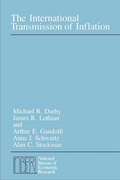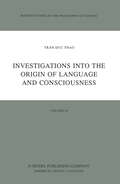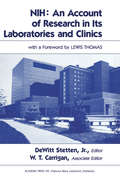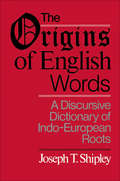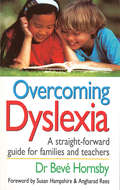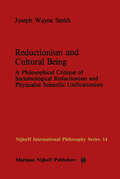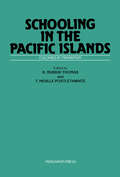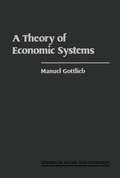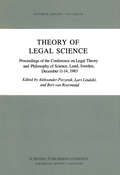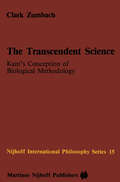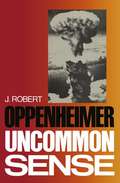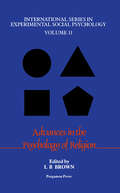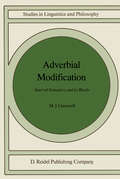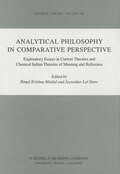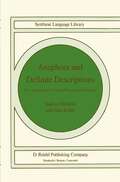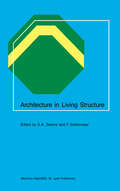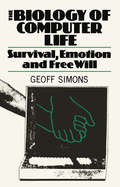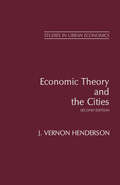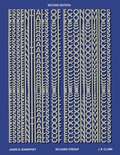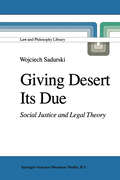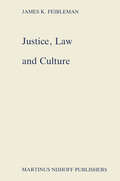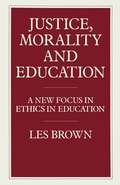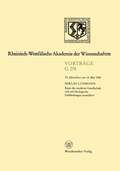- Table View
- List View
The International Transmission of Inflation (National Bureau of Economic Research Monograph)
by Michael R. Darby James R. Lothian Arthur E. Gandolfi Anna J. SchwartzInflation became the dominant economic, social, and political problem of the industrialized West during the 1970s. This book is about how the inflation came to pass and what can be done about it. Certain to provoke controversy, it is a major source of new empirical information and theoretical conclusions concerning the causes of international inflation. The authors construct a consistent data base of information for eight countries and design a theoretically sound model to test and evaluate competing hypotheses incorporating the most recent theoretical developments. Additional chapters address an impressive variety of issues that complement and corroborate the core of the study. They answer such questions as these: Can countries conduct an independent monetary policy under fixed exchange rates? How closely tied are product prices across countries? How are disturbances transmitted across countries? The International Transmission of Inflation is an important contribution to international monetary economics in furnishing an invaluable empirical foundation for future investigation and discussion.
The International Transmission of Inflation (National Bureau of Economic Research Monograph)
by Michael R. Darby James R. Lothian Arthur E. Gandolfi Anna J. SchwartzInflation became the dominant economic, social, and political problem of the industrialized West during the 1970s. This book is about how the inflation came to pass and what can be done about it. Certain to provoke controversy, it is a major source of new empirical information and theoretical conclusions concerning the causes of international inflation. The authors construct a consistent data base of information for eight countries and design a theoretically sound model to test and evaluate competing hypotheses incorporating the most recent theoretical developments. Additional chapters address an impressive variety of issues that complement and corroborate the core of the study. They answer such questions as these: Can countries conduct an independent monetary policy under fixed exchange rates? How closely tied are product prices across countries? How are disturbances transmitted across countries? The International Transmission of Inflation is an important contribution to international monetary economics in furnishing an invaluable empirical foundation for future investigation and discussion.
The International Transmission of Inflation (National Bureau of Economic Research Monograph)
by Michael R. Darby James R. Lothian Arthur E. Gandolfi Anna J. SchwartzInflation became the dominant economic, social, and political problem of the industrialized West during the 1970s. This book is about how the inflation came to pass and what can be done about it. Certain to provoke controversy, it is a major source of new empirical information and theoretical conclusions concerning the causes of international inflation. The authors construct a consistent data base of information for eight countries and design a theoretically sound model to test and evaluate competing hypotheses incorporating the most recent theoretical developments. Additional chapters address an impressive variety of issues that complement and corroborate the core of the study. They answer such questions as these: Can countries conduct an independent monetary policy under fixed exchange rates? How closely tied are product prices across countries? How are disturbances transmitted across countries? The International Transmission of Inflation is an important contribution to international monetary economics in furnishing an invaluable empirical foundation for future investigation and discussion.
Investigations into the Origin of Language and Consciousness (Boston Studies in the Philosophy and History of Science #44)
by Trân Duc ThaoTran Duc Thao, a wise and learned scientist and an eminent Marxist philoso pher, begins this treatise on the origins of language and consciousness with a question: "One of the principal difficulties of the problem of the origin of consciousness is the exact determination of its beginnings. Precisely where must one draw the line between the sensori-motor psychism of animals and the conscious psychism that we see developing in man?" And then he cites Karl Marx's famous passage about 'the bee and the architect' from Capital: ... what distinguishes the worst architect from the best of bees is this, that the architect raises his structure in the imagination before he erects it in reality. At the end of every labor process, we get a result that already existed in the imagination of the laborer at its commencement. (Capital, Vol. I, p. 178, tr. Moore and Aveling) Thao follows this immediately with a second question: "But is this the most elementary form of consciousness?" Thus the conundrum concerning the origins of consciousness is posed as a circle: if human consciousness pre supposes representation (of the external reality, of mental awareness, of actions, of what it may), and if this consciousness emerges first with the activity of production using tools, and if the production of tools itself pre supposes representation - that is, with an image of what is to be produced in the mind of the producer - then the conditions for the origins of human
NIH: An Account of Research in Its Laboratories and Clinics
by DeWitt StettenNIH: An Account of Research in Its Laboratories and Clinics contains collected accounts of the Intramural Research Program, as they happened in the laboratories and clinics, in various installations of the National Institutes of Health across the U.S.A. One paper discusses the etiology of schizophrenia which notes that, based on evidence and expanded adoption studies by Ketty, Rosenthal, and Wender, genetic factors actually contribute to the development of the disease. In developing countries, schizophrenia follows a more benign course. Some papers describe bacteriology, mycology, viral hepatitis, basic immunology, clinical immunology, and the development of enzymology. Researchers studying proteins elucidate on the synthesis and folding of protein chains, protein conformation and dynamics, the semisynthesis and protein function, as well as on sequence analysis and collagen research. Other papers describe the breaking of the genetic code, the progress made from the genetic code to beta thalassemia, to investigations of genetic diseases (such as galactosemia, gout, Lesch-Nyhan disease, mucopolysaccharide storage disease, and sickle cell disease). One paper notes the contribution of the intramural clinical research program of the National Cancer Institute to cancer therapy with emphasis in cancer chemotherapy. Professors in pharmacology, practitioners of general medicine, specialists or researchers dealing with microchemistry, toxicology, drug therapy, or oncology will find the collection valuable.
The Origins of English Words: A Discursive Dictionary of Indo-European Roots
by Joseph Twadell ShipleyThere are no direct records of the original Indo-European speech. By comparing the vocabularies of its various descendants, however, it is possible to reconstruct the basic Indo-European roots with considerable confidence. In The Origins of English Words, Shipley catalogues these proposed roots and follows the often devious, always fascinating, process by which some of their offshoots have grown.Anecdotal, eclectic, and always enthusiastic, The Origins of English Words is a diverting expedition beyond linguistics into literature, history, folklore, anthropology, philosophy, and science.
Overcoming Dyslexia: A Straightforward Guide For Families And Teachers
by Dr Beve HornsbyDyslexia is a common diagnosable condition that is estimated to affect at least one child in ten. In its most usual form it is manifested as a difficulty in learning to read and write, but it is widely misunderstood and often mistaken for low intelligence or even laziness. Dr Beve Hornsby combines her experience as a psychologist, teacher and speech therapist in this informative and reassuring book for parents and teachers of children suffering from a disability no-one can see or understand, and offers advice on how to identify, tackle and eventually overcome dyslexia. Includes up-to-date information on Attention Deficit Disorder and the relevance of the latest Education Act.
Reductionism and Cultural Being: A Philosophical Critique of Sociobiological Reductionism and Physicalist Scientific Unificationism (Nijhoff International Philosophy Series #14)
by J.W. SmithSchooling in the Pacific Islands: Colonies in Transition
by R. Murray Thomas T. Neville PostlethwaiteSchooling in the Pacific Islands: Colonies in Transition is the third book in a three-volume series describing education in selected countries of Oceania and the Asian regions bordering the Pacific. Organized into 10 chapters, this book begins with a general outlook on the colonization and schooling in Oceania. Subsequent chapters detail Oceania schools' social and historical backgrounds, the goals of education, the structure and size of the schooling enterprise, administration and finance, curriculum development, the supply of educational personnel, and problems and prospects for the future. Individual island countries covered include Papua New Guinea, Micronesia, New Caledonia and the Society Islands, Vanuatu, Fiji, American Samoa and Western Samoa, Tonga, and The Cook Islands.
A Theory of Economic Systems
by Manuel GottliebA Theory of Economic Systems is a systematic inquiry into the nature of historical economic systems, their relationships to each other, their peripheral areas, and the ways in which they and their components have evolved over time. Topics covered include modes of production; coordination of resource use; functions of the state in the economy; and the institutions of money and property.Comprised of nine chapters, this book begins with a brief introduction to the frame of reference; basic definitions of the terms used in economic systems; methodological issues; and the bounds of the inquiry. The next chapters are devoted to modes of production or forms of productive organization. Ten distinct modes of production are identified, with different modes sometimes dominant in different fields of economic activity (agriculture, industry, wholesale trade, urban services, etc.). The way the use of economic resources is coordinated both within and between modes is considered, with particular reference to markets, rationing, and central planning. Subsequent chapters focus on the role of the state and the public economy in economic systems; money and property; the ways in which separate economic systems may be drawn into meaningful multinational gestalts or orders; and problems of system classification. The book concludes by listing eight broad family types of systems into which most, if not all, historically experienced systems may fit.This monograph should appeal to social scientists in varied fields of specialization such as geography, sociology, economic history, political science, and economics.
Theory of Legal Science: Proceedings of the Conference on Legal Theory and Philosopy of Science Lund, Sweden, December 11–14, 1983 (Synthese Library #176)
by Aleksander Peczenik Lars Lindahl Bert Van RoermundProceedings of the Conference on Legal Theory and Philosophy of Science, Lund, Sweden, December 11-14, 1983
The Transcendent Science: Kant’s Conception of Biological Methodology (Nijhoff International Philosophy Series #15)
by C. ZumbachThe most neglected sector of Kant's Critical Philosophy is his collec tion of remarks about biological phenomena in the second part of the Critique of Judgment, the Critique of Teleological Judgment. The reasons for this are numerous, but since in Kant, everything comes in threes, a three-fold collection will suffice. The Critique of Teleological Judgment itself is one reason. More than most of his writings, this segment of the Critical corpus suffers from what can most charitably be termed "mistakes of exposition. " In this part of the third Critique, it is commonplace to find sub-arguments in Kant's general position somewhere other than their logical niche. The result is that the general theme behind his remarks about living phenomena is obscured. This difficulty has done much to discourage even the most enthusiastic of Kant admirers from investing their time on this work. Secondly, in this century, until very recently, there has been little interest in philosophical questions about biology. Twenty-one out of thirty-one sections of the Critique of Teleological Judgment (sections #61 and 63-83) deal either directly or indirectly with issues of interest in the philosophy of biology. Finally, the Critique of Teleological Judgment has been placed among the last on that list "of writings thought to formulate Kant's Critical system. This is not merely because of its temporal position.
Uncommon Sense
by J. Robert OppenheimerJ. Robert Oppenheimer, a leading physicist in the Manhattan Project, recognized that scientific inquiry and discovery could no longer be separated from their effect on political decision-making, social responsibility, and human endeavor in general. He openly addressed issues of common concern and as a scientist accepted the responsibility brought about by nuclear physics and the atom bomb. In this collection of essays and speeches, Oppenheimer discusses the shift in scientific awareness and its impact on education, the question of openness in a society forced to keep secrets, the conflict between individual concerns and public and political necessity, the future of science and its effects on future politics---in short, the common and uncommon sense we find in our modern day reality.
Advances in the Psychology of Religion (International Series in Experimental Social Psychology #Volume 11)
by Michael ArgyleThis collection of previously unpublished papers, written by well known researchers in the psychology of religion, is unique in its broad coverage and in its comparison between quite different and strictly theoretical perspectives. The subjects range from theoretical analyses of social science perspectives on religion and its methods, to reports of experimental, correlational or descriptive studies of religious experience and attitudes. The emphasis throughout is on the directions in which this work might move in the future.
Adverbial Modification: Interval Semantics and Its Rivals (Studies in Linguistics and Philosophy #28)
by M.J. CresswellAdverbial modification is probably one of the least understood areas of linguistics. The essays in this volume all address the problem of how to give an analysis of adverbial modifiers within truth-conditional semantics. Chapters I-VI provide analyses of particular modifiers within a possible worlds framework, and were written between 1974 and 1981. Original publication details of these chapters may be found on p. vi. Of these, all but Chapter I make essential use of the idea that the time reference involved in tensed sentences should be a time interval rather than a single instant. The final chapter (Chapter VII) was written especially for this volume and investigates the question of how the 'situation semantics' recently devised by Jon Barwise and John Perry, as a rival to possible-worlds semantics, might deal with adverbs. In addition I have included an appendix to Chapter III and an introduction which links all the chapters together.
Analytical Philosophy in Comparative Perspective: Exploratory Essays in Current Theories and Classical Indian Theories of Meaning and Reference (Synthese Library #178)
by Bimal K. Matilal Jaysankar Lal ShawWe are grateful to the authors who wrote papers specially for this volume and kindly gave their permission for printing them together. None of these papers appeared anywhere before. Our special thanks are due to the first six authors who kindly responded to our request and agreed to join this new venture which we are calling 'comparative perspective' in ana lytical philosophy. In the introductory essay certain salient points from each paper have been noted only to show how 'com parative perspective' may add to, and be integrated with, mod ern philosophical discussion in the analytic tradition. Need less to say, any mistake, possible mis-attribution or misrepresentation of the views of the original authors of the papers (appearing in the said introductory essay) is entirely the responsibility of the author of that essay. The author apologizes if there has been such unintentional misrepresenta tion and insists that the readers should depend upon the orig inal papers themselves for their own understanding. For typo graphical problems it has not always been possible to use the symbols originally used by the authors, but care has been taken to use the proper substitute for each of them. Bimal K. Matilal ANALYTICAL PHILOSOPHY IN COMPARATIVE PERSPECTIVE: AN INTRODUCTION 1. The aim of this volume is to extend the horizon of philosophi cal analysis as it is practiced today.
Anaphora and Definite Descriptions: Two Applications of Game-Theoretical Semantics (Studies in Linguistics and Philosophy #26)
by Jaakko Hintikka J. KulasI n order to appreciate properly what we are doing in this book it is necessary to realize that our approach to linguistic theorizing differs from the prevailing views. Our approach can be described by indicating what distinguishes it from the methodological ideas current in theoretical linguistics, which I consider seriously misguided. Linguists typically construe their task in these days as that of making exceptionless generalizations from particular examples. This explanatory strategy is wrong in several different ways. It presupposes that we can have "intuitions" about particular examples, usually examples invented by the linguist himself or herself, reliable and sharp enough to serve as a basis of sharp generalizations. It also presupposes that we cannot have equally reliable direct access to general linguistic regularities. Both assumptions appear to me extremely dubious, and the first of them has in effect been challenged by linguists like Dwight Bol inger. There is also some evidence that the degree of unanimity among linguists is fairly low when it comes to less clear cases, even in connection with such relatively simple questions as grammaticality (acceptability). For this reason we have tried to rely more on quotations from contemporary fiction, newspapers and magazines than on linguists' and philosophers' ad hoc examples. I also find it strange that some of the same linguists as believe that we all possess innate ideas about general characteristics of humanly possible grammars assume that we can have access to them only via their particular consequences.
The Biology of Computer Life: Survival, Emotion and Free Will
by SIMONSThe doctrine of computer life is not congenial to many people. Often they have not thought in any depth about the idea, and it necessarily disturbs their psychological and intellectual frame of reference: it forces a reappraisal of what it is to be alive, what it is to be human, and whether there are profound, yet un expected, implications in the development of modern com puters. There is abundant evidence to suggest that we are wit nessing the emergence of a vast new family of life-forms on earth, organisms that are not based on the familiar metabolic chemistries yet whose manifest 'life credentials' are accumulating year by year. It is a mistake to regard biology as a closed science, with arbitrarily limited categories; and we should agree with Jacob (1974) who observed that 'Contrary to what is imagined, biology is not a unified science'. Biology is essentially concerned with living things, and we should be reluctant to assume that at anyone time our concept and understanding of life are complete and incapable of further refinement. And it seems clear that much of the continuing refinement of biological categories will be stimulated by advances in systems theory, and in particular by those advances that relate to the rapidly expanding world of computing and robotics. We should also remember what Pant in (1968) said in a different context: 'the biological sciences are unrestricted . . . and their investigator must be prepared to follow their problems into any other science whatsoever.
Economic Theory and the Cities (Research in Urban Economics)
by J. Vernon HendersonThe Second Edition of Economic Theory and the Cities has been revised and expanded with both the graduate student and the practicing professional in mind. Providing a state-of-the-art synthesis of important theoretical topics in urban economics, the volume emphasizes the fundamental links between urban economics and new developments in mainstream economic theory. From the Preface: In this book I present what I believe to be the most important theoretical topics in urban economics. Since urban economics is a rather diffuse field, any presentation is necessarily selective, reflecting personal tastes and opinions. Given that, I note on what basis I chose the material that is presented and developed. First, the basic spatial model of a monocentric city is presented, since it lays the foundation for thinking about many of the topics in urban economics. The consideration of space and spatial proximity is one central feature of urban economics that distinguishes it from other branches of economics. The positive and negative externalities generated by activities locating in close spatial proximity are central to analysis of urban phenomena. However, in writing this book I have tried to maintain strong links between urban economics and recent developments in mainstream economic theory. This is reflected in the chapters that follow, which present models of aspects of the most important topics in urban economics--externalities, housing, transportation, local public finance, suburbanization, and community development. In these chapters, concepts from developments in economics over the last decade or so are woven into the traditional approaches to modeling these topics. Examples are the role of contracts in housing markets and community development; portfolio analysis in analyzing housing tenure choice and investment decisions; the time-inconsistency problem in formulating long-term economic relationships between communities, developers, and local governments; search in housing markets; and dynamic analysis in housing markets and traffic scheduling. The book ends with chapters on general equilibrium models of systems of cities, demonstrating how individual cities fit into an economy and interact with each other. This book is written both as a reference book for people in the profession and for use as a graduate text. In this edition, a strong effort has been made to present the material at a level and in a style suitable for graduate students. The edition has greatly expanded the sections on housing and local public finance so these sections could be studied profitably by a broad range of graduate students. Recommended prerequisites are an undergraduate urban economics course and a year of graduate-level microeconomic theory. It is possible that the book can be used in very advanced undergraduate courses if the students are well versed in microeconomics and are quantitatively oriented.Focus on the basic spatial model of the monocentric cityExpanded sections on housing and local public financeDiscussion of the critical role of spatial proximity of different economic activities, such as housing, transportation, and community development
Essentials of Economics
by James D Gwartney Richard Stroup J. R. ClarkEssentials of Economics, Second Edition is a text intended for a one-term course in economics for college students. It attempts to teach students of the analytic way of studying economics and provides the basics of the concept of political economy and uses this knowledge to explain the choice process in the public sector. The book presents a comprehensive survey of economics. It contains chapters that highlight the importance of the microincentive structure of macroeconomic markets; identifies the determinants of supply, as well as the impact of public policy on those determinants; and presents both adaptive and rational expectations theory. The linkage between production theory and the cost curves faced by the firm; examination of the market structure; and the role of regulation and deregulation are covered as well.Economics students will find the book very useful.
Giving Desert Its Due: Social Justice and Legal Theory (Law and Philosophy Library #2)
by Wojciech SadurskiDuring the last half of the twentieth century, legal philosophy (or legal theory or jurisprudence) has grown significantly. It is no longer the domain of a few isolated scholars in law and philosophy. Hundreds of scholars from diverse fields attend international meetings on the subject. In some universities, large lecture courses of five hundred students or more study it. The primary aim of the Law and Philosophy Library is to present some of the best original work on legal philosophy from both the Anglo-American and European traditions. Not only does it help make some of the best work avail able to an international audience, but it also encourages increased awareness of, and interaction between, the two major traditions. The primary focus is on full-length scholarly monographs, although some edited volumes of original papers are also included. The Library editors are assisted by an Editorial Advisory Board of internationally renowed scholars. Legal philosophy should not be considered a narrowly circumscribed field.
Justice, Law and Culture
by J.K. FeiblemanThe following pages contain a theory of justice and a theory of law. Justice will be defined as the demand for a system of laws, and law as an established regulation which applies equally throughout a society and is backed by force. The demand for a system of laws is met by means of a legal system. The theory will have to include what the system and the laws are in tended to regulate. The reference is to all men and their possessions in a going concern. In the past all such theories have been discussed only in terms of society, justice as applicable to society and the laws promul gated within it. However, men and their societies are not the whole story: in recent centuries artifacts have played an increasingly important role. To leave them out of all consideration in the theory would be to leave the theory itself incomplete and even distorted. For the key conception ought to be one not of society but of culture. Society is an organization of men but culture is something more. I define culture (civilization has often been employed as a synonym) as an organization of men together with their material possessions. Such possessions consist in artifacts: material objects which have been altered through human agency in order to reduce human needs. The makers of the artifacts are altered by them. Men have their possessions together, and this objectifies and consolidates the culture.
